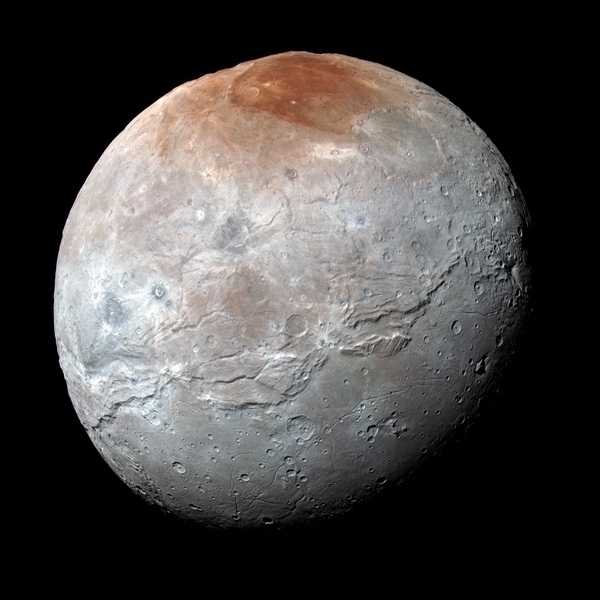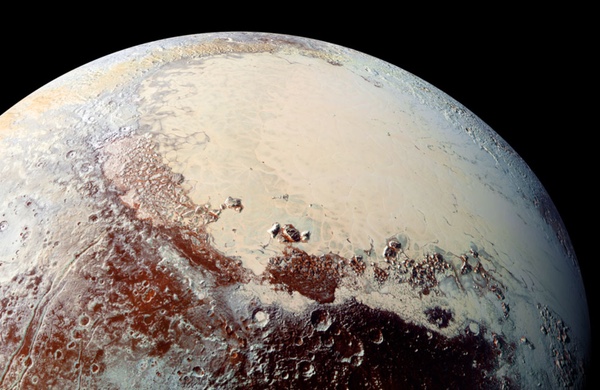Delayed gratification: early results from the New Horizons Pluto flybyby Jeff Foust
|
| Pluto, Stern noted, looks very different than Charon. “It probably tells us that the other worlds in the Kuiper Belt are going to be very different from one another.” |
The gratification, while delayed, has arrived for Stern and his science team. The mission has dribbled out images and other data in the weeks since the flyby, which they consolidated into a paper published in the journal Science last week, the first formal scientific results of the mission. That paper draws few firm conclusions about Pluto and its moons, given the limited data returned to date, and the limited time to analyze that data, but offers some hints about the ongoing analysis.
The images quickly dispelled the belief that Pluto might be similar to Neptune’s largest moon, Triton, similar in size to Pluto and believed to be a captured Kuiper Belt object. “However, our assessment is that the geologies of both worlds are more different than similar, although more quantitative consideration of this must await further data downlinks,” the paper states.
“Pluto is a very complex world,” Stern said in his MIT talk. It’s notably different, he noted, than its largest moon, Charon, which likely formed after a giant impact of a body with Pluto. “It probably tells us that the other worlds in the Kuiper Belt are going to be very different from one another.”
Pluto has offered plenty of surprises to scientists, such as mountains as tall as North America’s Rockies, but made of water ice. “Immediately upon seeing these, we knew Pluto’s crust must be made of water ice,” Stern said, despite a strong spectroscopic signature of nitrogen, because only water ice was strong enough to support mountains as tall as those seen by the spacecraft.
Other images shown dendritic channels that indicate “some fluid or slurry moved through and carved those channels,” Stern said. “It may be telling us that in the past, Pluto has gone through epochs where it had a much thicker atmosphere and was able to support liquids on its surface.”
Another surprise is a region of the surface, tentatively named Sputnik Planum, virtually devoid of craters. That means the surface is very young: no more than 100 million years old, he said. “This was created yesterday, geologically,” he said. That, in turn, means that Pluto’s interior is still active to resurface those regions, even though there’s no obvious mechanism to support that activity. “It’s sending a lot of geophysicists back to the drawing board.”
While Pluto was “the star” of the flyby, as Stern put it, Charon is very interesting in its own right. “Everything we’re seeing here, to first order, is water ice,” he said while showing an image of the moon. That’s not a surprise, but what is a surprise is the moon’s complex geology, with an old, cratered northern region and much younger plains in the south, separated by a canyon larger the Grand Canyon.
| “The very best data is still on the spacecraft,” Stern said. “We only have about 15 percent of the data from the flyby down on the ground already.” |
There’s also a dark feature on Charon’s north pole that eludes explanation for now. “We don’t understand this feature at the north pole. We’ve never seen anything like it anywhere else in the solar system,” he said. One possibility mentioned in the Science paper is “cold trapping” of volatiles, which are then darkened, and also reddened, by exposure to radiation. “But it’s pretty early days,” he said.
 Images of Charon show complex terrain, with older, darker regions in the north separated from younger regions in the south by a giant canyon. (credit: NASA/JHUAPL/SwRI) |
That disclaimer—pretty early days—could apply to the science about the mission in general. With only three months since the flyby, and with only a fraction of the data returned, the results released so far have, unsurprisingly, raised more questions than they have answered.
One of those open questions is about something relatively basic: the pressure of Pluto’s tenuous atmosphere. Measurements by New Horizons showed that the atmospheric pressure at Pluto’s surface is only about 10 microbars. That’s significantly less than past calculations of atmospheric pressure made by groundbased observations, taking advantage of stellar occultations—when Pluto passes in front of a distant star—to probe its atmosphere.
Stern, in an interview after his talk, said that the atmospheric pressure measurement from New Horizons is “solid.” One explanation is that models used to explain groundbased stellar occultation data are inaccurate. Another, he said, is that Pluto’s atmosphere has changed in the last couple of years, possibly beginning to freeze out at Pluto recedes from the Sun its elliptical orbit.
As it turns out, astronomers observed a stellar occultation of Pluto in late June, just a couple weeks before the flyby. Stern said he has not heard the results of the analysis of the occultation by various teams, including one that used NASA’s SOFIA airborne observatory. Those results may come next month at the annual meeting of the American Astronomical Society’s Division for Planetary Science outside Washington, DC, with dozens of talks about Pluto planned for the first two days of the week-long event.
In the meantime, more data is coming back from New Horizons every week. “The very best data is still on the spacecraft,” Stern said, such as high-resolution images and spectra. “We only have about 15 percent of the data from the flyby down on the ground already.”
That slow data download, dictated by the spacecraft’s great distance from the Earth and its limited power, is in some respects a public relations boon for the mission. In recent weeks, the mission has released a new set of images every Thursday, offering some incremental science results as well as stunning—and often head-scratching—new views of Pluto and its moons. That’s likely to keep the mission in the news for months to come: New Horizons won’t complete the transmission of data from the flyby until late next year.
And New Horizons’s mission isn’t over yet, even after the last bits of data from the flyby make it back to Earth next year. The spacecraft will soon start firing its thrusters to change course towards a Kuiper Belt object, 2014 MU69. That maneuver will send the spacecraft past the object, about 45 kilometers in diameter, making its closest approach on New Year’s Day 2019.
“This is going to be really fascinating,” Stern said of that upcoming flyby. The object is intermediate in size between Pluto and comet 67P/Churyumov–Gerasimenko, the object currently being studied by ESA’s Rosetta spacecraft and which also originated from the Kuiper Belt. “We’re going hopefully to be able to connect the dots of planetary accretion by studying this object and its composition, which has been in a deep freeze for four billion years,” he said.
| “We’re going hopefully to be able to connect the dots of planetary accretion by studying this object and its composition, which has been in a deep freeze for four billion years,” he said of the planned 2019 Kuiper Belt object flyby. |
That flyby still requires approval of, and funding by, NASA. Stern said the mission will write a proposal next spring to seek funding for an extended mission as part of the agency’s “senior review” of ongoing planetary missions. It’s widely believed, though, that as long as the spacecraft is in good health, that extended mission will win approval, given there’s no opportunity to send another spacecraft to the Kuiper Belt for the foreseeable future.
In the meantime, that trickle of data from New Horizons will continue, helping scientists unravel some mysteries of Pluto while uncovering new ones. Stern, in his conference talk, noted that the mission came up with a detailed communications plan for the flyby, determining “the kinds of stories we wanted to tell” about the mission. But the flyby was bigger than their expectations.
“Pluto is a great brand,” he said. “It took off by itself, and all we had to do was light a match.”
